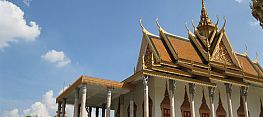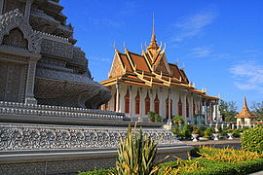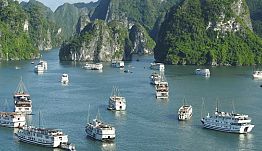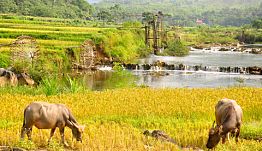Destinations
Phnom Penh
Explore the capital city of the Kingdom of Cambodia.
Phnom Penh was established in 1422 by King Podhea Yat when he abandoned the then captial city of Angkor and built five wats in Phnom Penh on the confluence of the Mekong and Tonle Sap Rivers. Phnom Penh is also the permanent location of the Government.
Development continued after the independence of Cambodia in 1953 but was halted abruptly by the coup of the Khmer Rouge. The city was completely evacuated by the regime. It remained empty until the fall of the Khmer Rouge in 1979, after which those who had survived the Killing Fields began to return almost immediately. UN sponsored elections in 1993 initiated a new era of growth which continues today.
Highlights of the City:
Royal Palace
Central Phnom Penh, located on the riverfront. The Palace, built in 1866 under the French protectorate and King Norodom.
Silver Pagoda
Within the grounds of the Royal Palace, the Silver Pagoda is so named for its amazing floor which is made entirely of silver tiles.
National Museum
Is located next to the Royal Palace. It’s 5,000 displays include an extensive collection of Angkorian era statues and other artifacts.
The Riverfront
Enjoy a romantic stroll along Phnom Penh's Sithowath Quay to enjoy the view of the confluence of the Mekong and Tonle Sap Rivers. The water level varies greatly depending upon what time of the year you visit and is at it’s highest at the end of the rainy season in October. The sunrise can be spectacular over the river in front of the Royal Palace. There are also regular 2-hour cruises during the day which are particularly pleasant if combined with lunch or dinner and sunset on board a cruising restaurant.
Wat Phnom
Located in North Phnom Penh. A beautiful, active Buddhist wat atop a small hill which was the original founding site of Phnom Penh. The legend tells of the beautiful Lady Penh who retrieved four Buddha statues from a floating koki tree and built a hill (Phnom) to house them. It is a tranquil place to catch a cool breeze and watch pilgrims pay their respects and visit the fortune tellers there.
The Markets and Shopping
If you have time you should try and visit at least one traditional market while you are in Phnom Penh. The two best known are The Russian Market and the Central Market. The Russian Market is not so centrally located but is the best for souvenirs, curious and silks and the vendors appear to be more realistic in their expectations.
The 1935 art deco-style Central Market is architecturally interesting but is geared almost entirely to the tourist who doesn’t have time to venture further afield and the vendors are more feisty.
More exclusive shopping can be found along Streets 178 and 240 where there are a number of elegant boutiques and galleries displaying contemporary Cambodian art, fine silks and sculptures.
The Old Market
The Old Market of Siem Reap is a treasure trove for tourists and locals alike.
Located in the Old French Quarter it is split roughly into two parts. The northern end of the market, furthest from the river, is where the locals go to buy fresh produce and clothing. It is also an excellent place to marvel at the numerous food stalls at the very edge of the market, where traditional, local dishes are imaginatively cooked in cramped, difficult conditions.
The southern part of the market, bordering on the river bank, has evolved into a shopping haven for tourists.
Silks and Handicrafts
Traders offer every type of Cambodian handicraft, from bolts of silk to handmade garments, from statues, wood carvings and religious artefacts to postcards, t-shirts and generic souvenirs. Musical instruments, basketwork, semi-precious stones, jostle for space alongside prints, paintings and silverwork.
The traditional, and ubiquitous, Cambodian scarf, the red gingham krama will be found on sale here. A cheap and easy to carry keepsake, it can also be useful to keep the sun off your neck while you wander round the market, absorbed, for many hours!
Bartering
Many bargains are to be had and prices can be further driven down by bartering as they are almost always inflated for the tourist trade. There will often be items of the apprentice's handiwork alongside the master's and the price and quality will reflect this difference.
Wander around at leisure and soak up the atmosphere, it is both fascinating and educational. The streets around the Old Market offer a similar but slightly more sophisticated offering to the Western souvenir hunter. Choose your own locally produced silk and have clothes or soft furnishings made to measure on the spot.
The many galleries offer traditional craftsmanship but there are a growing number of artists exhibiting contemporary pieces. Some galleries will arrange shipping so there are no worries about how to get your newly acquired stone carving home.




